Aggression between dogs in the same household is fairly common. In this article I’ll give you some ideas on what to do if your dogs don’t get along.
Looking at my Instagram feed, you might assume my dogs are best friends and everything in our house is peaceful. That we all get along.
That is not reality.
At the time of this writing, my dogs are ages 12 years and 2 years. Nearly a generation apart.
They are on opposite ends of the “spectrum” in so many ways – energy, training, maturity.
My senior dog moves at the pace of a sloth. My adolescent weimaraner … drags me.
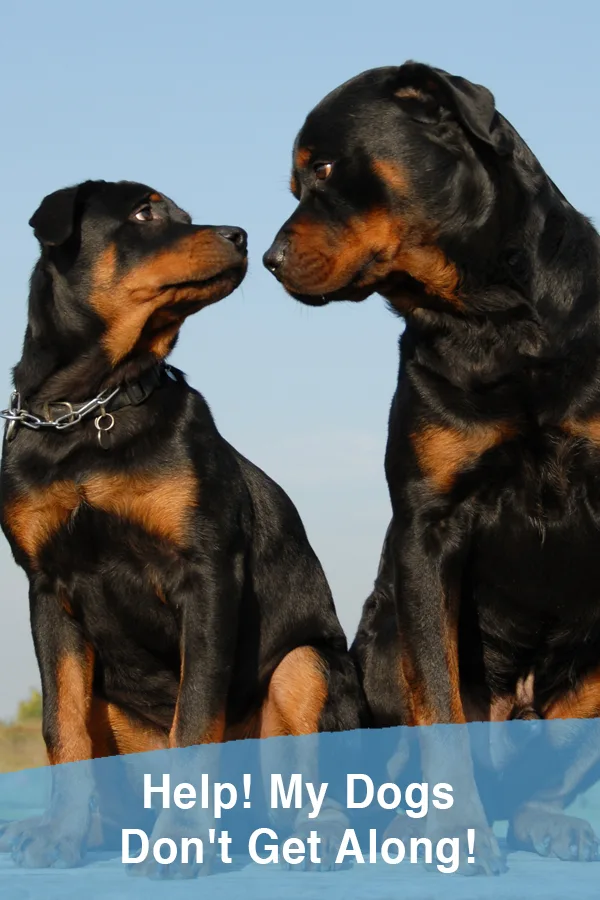
Because of their differences, my dogs co-exist, but they rarely do things together. I walk them separately. They don’t play. When I write, they each curl up on a separate dog bed.
So when I see my dogs cuddling together, I can’t help but take a picture and post it.
But as anyone with multiple dogs knows, more than likely you’re going to have a few growls, barks and scuffles at some point. Maybe even a few fights.
Dogs are DOGS, and sometimes dogs bark, growl and bite.
So if your dogs don’t always get along, know that this is normal.
Sometimes you might have a more serious issue, and in that case I would recommend working with a trainer.
More often than not, it simply comes down to management and making smart decisions.
I know my dogs will fight over rawhides, Kongs, bully sticks or food, for example. So I don’t give them the opportunity.
They eat in separate areas and they enjoy their “goodies” in separate rooms. That is what works for us.
Here are some common “high valued” resources that could trigger a fight between some dogs:
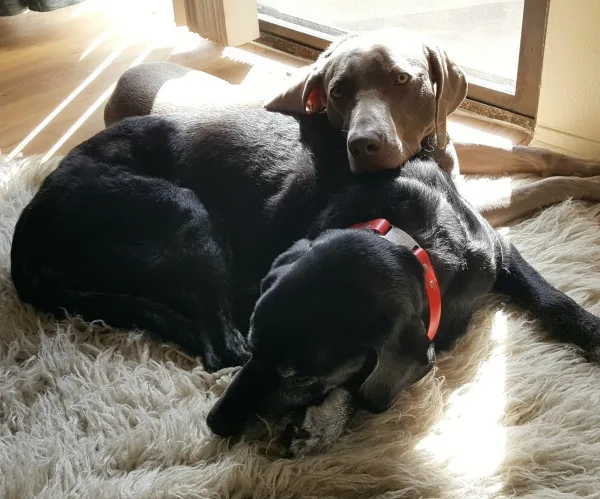
High-value resources for dogs
- Bones, Kongs, rawhides, bully sticks
- Food, food bowls or water bowls
- Dog beds or kennels/crates
- Toys
- Doorways or other thresholds
- A favorite person (family member, dog walker, relative, etc.)
- A spot on the couch or a chair
- Another dog
Signs of tension or guarding to watch for:
- Stiff, still posture
- Lowered head
- Raised hackles
- Cold, hard stare
- Flicking the tongue
- Raised lips, showing teeth
- Growling
See my post: Signs of stress in dogs
Note that you have to look at these things in context and know your dogs. Raised hackles does not always mean aggression, for example.
*Enjoying this article? Get realistic dog training tips emailed once a week. Click Here
What to do if your dogs don’t get along
1. List out exact “triggers” in detail. Keep notes.
Sometimes you might not know exactly why your dogs are fighting. It helps to take detailed notes on each situation.
Where did the fight occur? What time of day? Who was there? What items were present?
Which dog seemed to “start it” and why? How long did it last?
Write down these details so you can look for patterns and better manage your dogs in the future.
2. Management of dog aggression to keep everyone safe.
Management comes down to preventing opportunities for your dogs to fight.
Once you know what causes problems between your dogs, you can generally prevent most issues.
- If certain items cause issues between your dogs, you’ll know to pick up toys, food bowls, bones, etc.
- Using a gate or kennels/crates can also go a long way when you need to keep your dogs separated during meals or other “exciting” situations that can trigger fights.
- If you notice tension, re-direct one or both dogs with an upbeat “look hear!”, whistling or clicking your tongue
In our house, my dogs will fight over me if I’m sitting on the ground. If your dogs do this, don’t sit on the ground petting one dog unless you tell the other dog to “STAY.” Or, use gates or leashes to manage them.
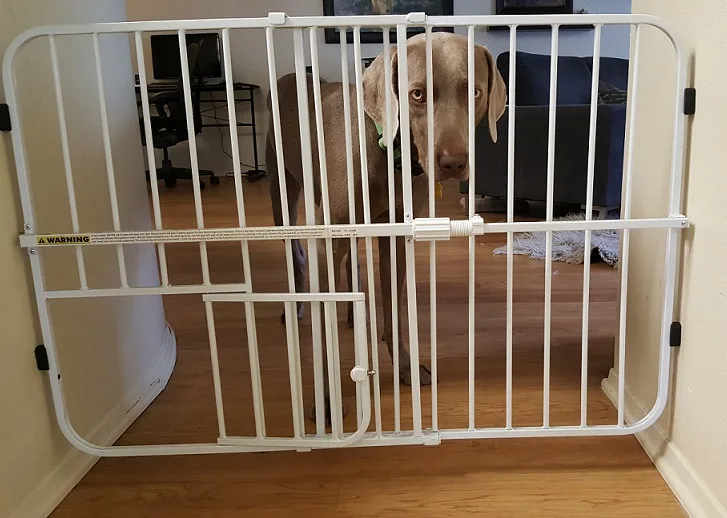
3. Work with a trainer if you need it.
Usually fights between dogs are over in a second and sound a lot worse than they are.
However, if you are concerned for either dog’s safety or your own safety, it is smart to consult with a trainer.
Even if you know a lot about dog behavior, it’s worth it to get a neutral opinion from someone who can observe you and your dogs.
It’s hard to recognize behaviors from our own dogs because we are biased or emotional.
4. Don’t force interactions between your dogs.
Dogs don’t have to be best friends. They just need to co-exist.
When we got our weimaraner puppy in 2016, I was planning on taking cute photos of the dogs together the day we got our puppy.
Turns out, my senior dog would snarl at our puppy if they were too close so I didn’t get many pictures of them together at all when Remy was little!
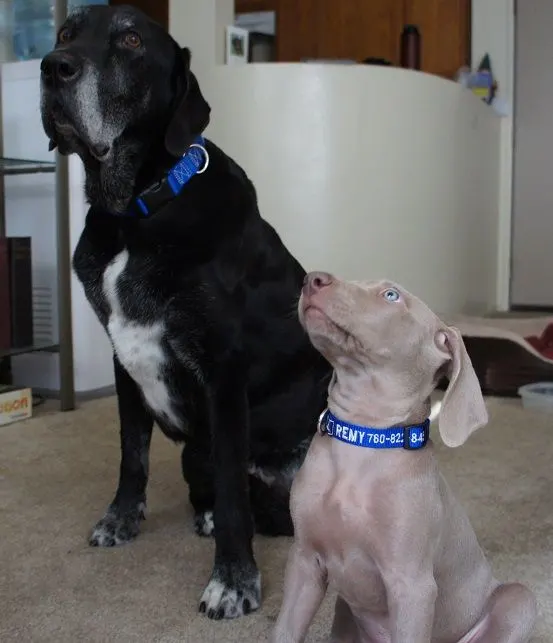
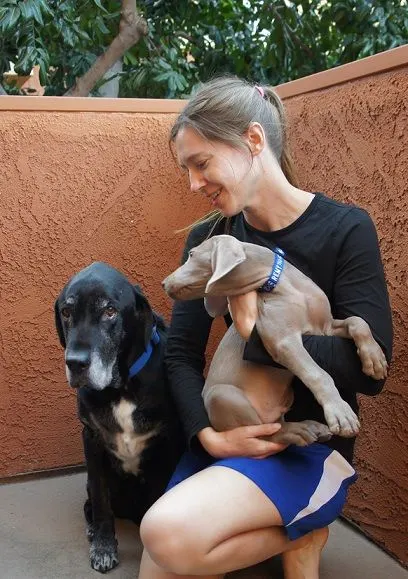
This is just one example of how you have to change plans sometimes to accommodate your dogs’ needs.
Don’t force your dogs beyond their limits, and don’t rush. I have a good example below of a mistake I made that caused a fight between my dogs recently.
Unfortunately, dog fights are often the person’s fault. It all goes back to management, prevention and making smart choices.
5. Walk the dogs together if possible.
Most dogs will get along during a walk, and this is a great way to involve your whole family. The dogs are out doing something fun together with no pressure. They are spending time together in a positive, safe way.
My senior dog can be a complete grouch in the house, but when I take my two dogs outside they get along much better.
They like to follow each other around sniffing the same plants and grassy areas together. When we first got our puppy, this was the best way to let my two dogs interact.
*Enjoying this article? Get realistic dog training tips emailed once a week. Click Here
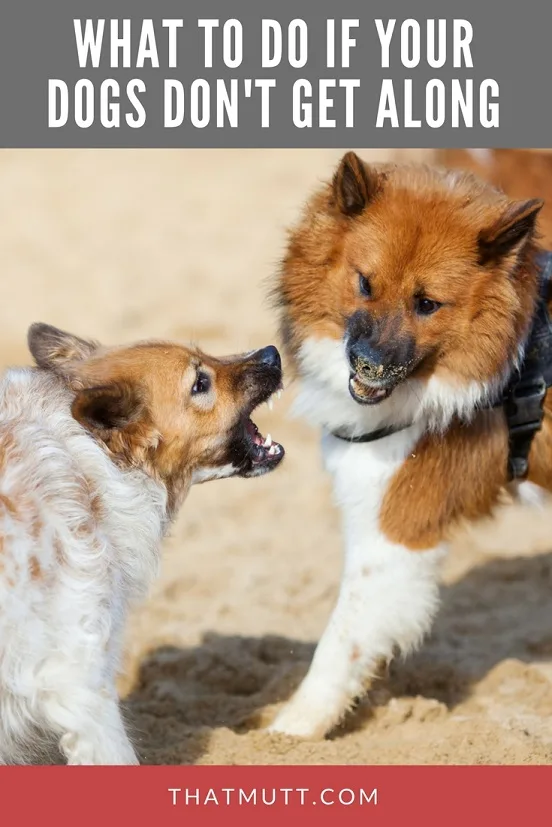
Other tips and factors on aggression between dogs:
- Avoid greeting your dogs excitedly, especially in doorways or tight spaces
- If a fight breaks out, try to startle the dogs with a loud “hey!” or clap your hands. Or you can try throwing water on them.
- Separate your dogs when they’re home alone
- Consider spaying/neutering. This won’t solve your problem but it can help along with training.
- Don’t allow dogs to excitedly greet visitors together. Too much excitement can sometimes trigger a fight.
- Don’t allow too much excitement running and playing in the yard together
- Use a muzzle if needed
- Some dogs just aren’t a good fit and it might be best to re-home one dog.
- One dog may be grouchy due to pain
- Stay calm. Sometimes people trigger tension or aggression by adding too much excitement or tension to the situation
- Make sure each dog gets plenty of exercise and training
Aggression between dogs in the same household – An example
My senior dog Ace raises his lips and shows teeth whenever Remy the weimaraner tries to curl up next to him.
Remy likes to test Ace’s seriousness by tip-toeing closer and giving him a quick lick to the nose.
Sometimes Ace will give in and let Remy in for a cuddle. Usually they have a harmless “argument” where they bark until Remy walks away. It’s just “talk” and they do this every day.
But last week, I was sitting on the floor petting Ace when this happened.
Anyone reading this will see my obvious mistakes.
Normally Ace would growl, Remy would bark and then walk away. But this time I tried to coax Remy closer.
I caused tension by pushing my dogs too far.
For 3 seconds they got into an actual fight biting at each other until one of them bit ME.
I set them up for the fight to begin with and then I put my hands in the mix.
Do NOT put your hands into a dog fight, people. Doh!
Of course, after this “explosion” my dogs forgot about it instantly as dogs tend to do.
They shook themselves off and within the hour they were curled up TOGETHER on the dog bed like nothing happened.
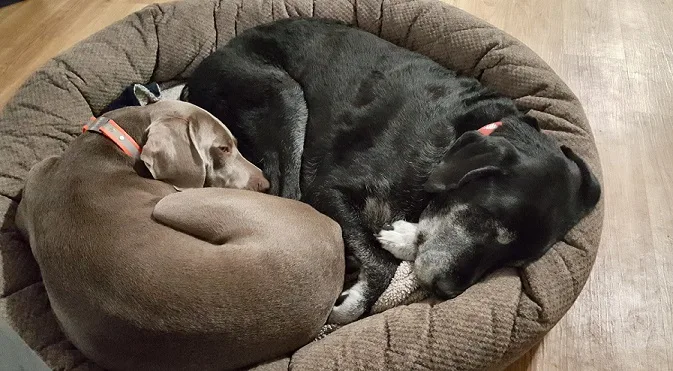
Dogs …
I wanted to share that story because living with multiple dogs takes some work, and it’s never going to be perfect.
My two guys are very easygoing, and I have a lot of experience managing dogs through fostering and pet sitting. But sometimes I still make mistakes.
I hope this post gives you some ideas for handling your own dogs, and if you need some help from a trainer, don’t hesitate to do so.
Do you have multiple dogs? How do they generally get along?
What other tips would you add to this list?
Let me know in the comments!
*Enjoying this article? Get realistic dog training tips emailed once a week. Click Here
More resources:
- How to break a dog’s possessiveness
- How to introduce your dog to a new puppy
- How to introduce dogs
- What to do if your dog is aggressive to your new puppy
- My dog growls at other dogs – what to do
- Dog to dog resource guarding – Patricia McConnell
Lindsay Stordahl is the founder of That Mutt. She writes about dog training, dog exercise and feeding a healthy raw diet.

Kaylee
Thursday 17th of March 2022
So my 2 year old willow is aggressive to a new addition Bentley. She attacked him over a bone so we figured ok that’s the trigger. But then today she attacked when they were just standing there. We love both dogs and don’t want to get rid of either one but we don’t want them injuring each other either. If you have any tips I am all ears
Beckie
Wednesday 3rd of November 2021
Hi I have 2 chihuahuas witch have lived together for 2 and a half years ,one is 2,and 1 is 5. And they do everything together,they sleep in a cage and have been fine up until now and the big one has bit the small one in about 4 places and can not understand it , the little one does like to play a lot but the big one doesn't like to play what should I do
Kayle Jensen
Monday 18th of October 2021
have a question for people with more dog knowledge than me! Daizi, 9 lb chorkie, 2 yrs old have had her since 6 wks. She’s always been a beta dog, very loving and laid back. (Last Yorkie was very alpha). Archie, 18 lbs, mix of who knows what (boxer, bull, terrier?) 1 yr old have had him since he was 8 mo old.
Archie seems to be abusing Daizi. He will run her over when she’s peeing, walk over and lift his leg on her, push her out of the way and eat out of the bowl she’s eating, constantly bite, knock her down and hold her down and literally take a chew out of her mouth.
Occasionally Daizi will go off on him but for the most part she cowers or let’s him have his way. She has become nervous and constantly on edge. We’ve been correcting him from day one but it’s gotten worse. I’m considering using the training collar for his behavior. Any other suggestions?
Lindsay Stordahl
Monday 18th of October 2021
I would do your best to manage him in situations where you know he'll be a bully. For example, feed them in separate areas, such as different rooms or one in a crate. Then pick the bowls up. For potty breaks, have your male dog leashed so he can't charge your female. You might have him drag a light leash around the house sometimes, so you can catch him and move him away from her if he tries to take her chew.
Deborah Daniel
Saturday 10th of July 2021
Hello! I am struggling with my two rescue dogs. Brett is 5 and we have had him for a little over 3 years. Bradford is almost 1 and we have had him about 3 months. Both pit mixes. They don’t start playing aggressively but it always turns into Bradford biting Brett and causing injury or just making him cry. Brett keeps going back for more anytime we put them together. We have gates all over the house and keep them separated 85% of the time. We have had 4 training sessions at our house but not for them together. I am struggling with re homing our second rescue. I feel like my first dog is getting beat up. Thank you
Esa Van Dusen
Wednesday 26th of May 2021
Dear Lindsday, thank you so much for writing this. My husband and I have an 8-year old Weim who is the most docile creature (would you believe his name is Remi? :) and adopted a now 3-year old pittie mix, Teddy, who has the happiest, silliest disposition. I have also worked in rescue and foster, and this is my first experience with having to acutely monitor signs and reestablishing boundaries in the home. After two years with us, Teddy went after Remi for treats- as in, he bit him. It was absolutely the first time he had ever shown aggression for something we had been doing with zero issue his entire time with us. No toy agression or food bowls. I firmly believe it is because we were not fully honoring Teddy for who he is- his need for routine, and need for a significant amount of exercise DAILY. In addition, we had just come from a long road trip where he was very much out of his routine- something we now understand he craves and our older dog does not. I've also learned it is better not to have male/male or female/female.
It's been about 2 weeks since the incidents (two separate occasions within 2 days). We still go on regular walks together, Teddy now goes to a great doggie daycare 3x a week where he's the belle of the ball and comes home tired, and we've instituted better boundaries. The issue is, they both seem very uncomfortable and not themselves in their own home. Teddy doesn't understand why his brother doesn't like him, and Remi seems very afraid (he has always been sensitive), especially if Teddy is in a main traffic part of the house, except he's just laying and relaxing. We were previously (and are!) a very loving crew and did everything together. Teddy is obsessed with our nieces and nephews, and he is just genuinely a wonderful, happy-go-lucky guy. I just wonder if Teddy craves more attention from his canine family member, who is barely interested and usually only when we're on walks or at the park. Of course, we want him to thrive and be appreciated, not just co-exist. In your experience, do you think it will just take a little time for our efforts to continue, and for them to settle back in?
Thank you so much for reading, and thank you again for this article.
Sincerely, Esa, Remi & Teddy